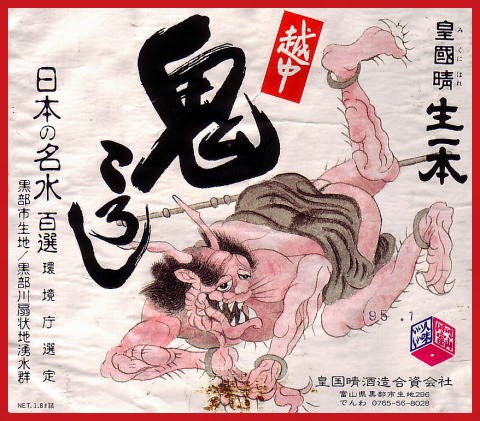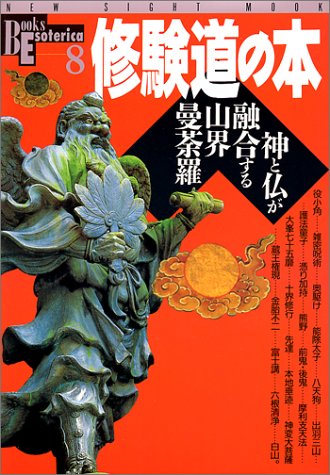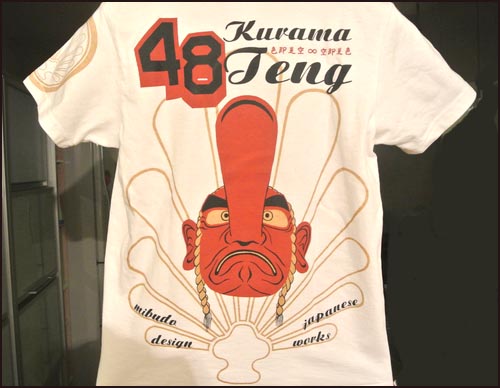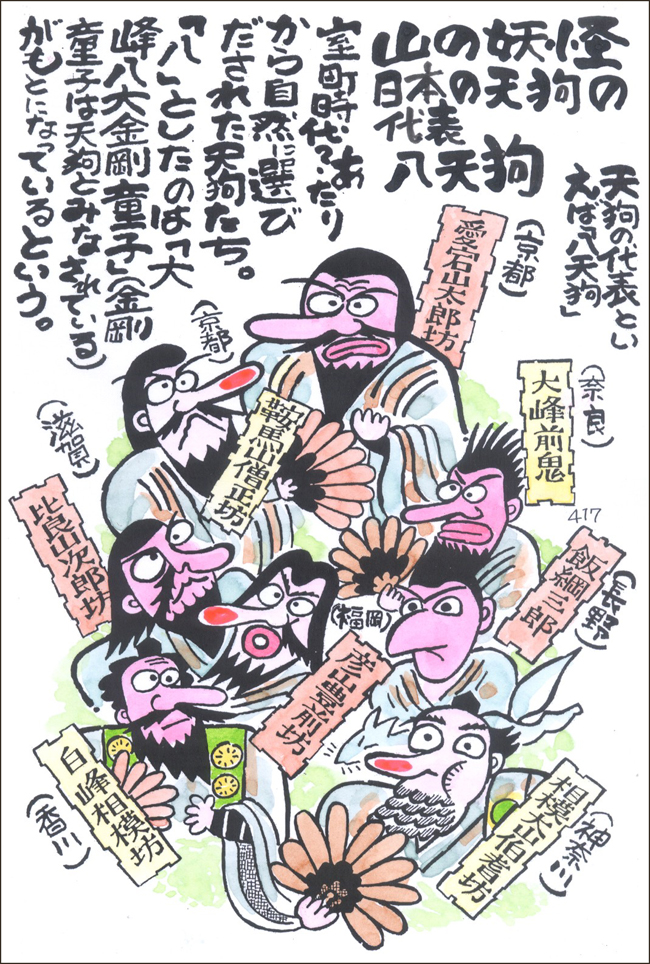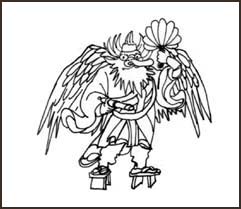. Onipedia - 鬼ペディア - Oni Demons - ABC-List - .
- for tsuina, see below -
:::::::::::::::::::::::::::::::::::::::::::::::::::::::::::::::::::::::::::::::::::::::::::::::::::::::::::::::::::::::::::::::::::::::::::::::::::::::::::::::::::::::::::::::::::
onigokko, oni-gokko 鬼ごっこ game of tag
onigoto 鬼ごと
Tag is a playground game that involves two or more players chasing other players in an attempt to "tag" or touch them, usually with their hands.
This game was already popular in the Edo period, in a version called :
ko o toro ko toro 子をとろ子とろ / 子を捕ろ子捕ろ "get hold of a child, get it!"

守貞漫稿 Morisada Manko
One player is the Oni, one is the parent and all the others are children. The children try to hide behind the parent. The Oni tries to grab the last child in line. The parent spreads out his arms and tries to ward off the Oni.
As they run, the row of children begins to sway like a serpent or a whirlpool.
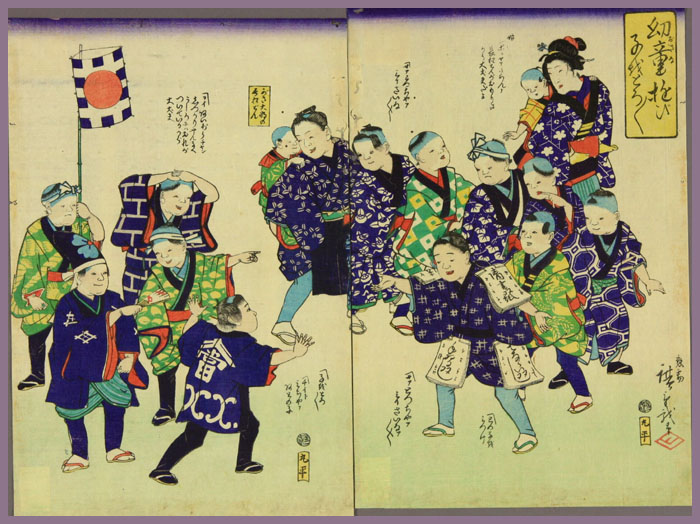
source : Waseda University Library
幼童遊び子をとろ子とろ osana asobi ko o toro ko toro
歌川広重 Utagawa Hiroshige
..............................................................................................................................................
This game has a long history, all the way to Hell,
where 地蔵菩薩 Jizo Bosatsu is trying to lead the poor souls out of hell, past the Oni guardian.

.......................................................................
During the Heian period, there was a ritual at the court called
onibarai no gishiki 鬼払いの儀式 "driving out the demons"
oniyarai 鬼遣らい
which is seen as the beginning of Onigokko.
This ritual was performed as a prayer for 五穀豊穣 gokoku hojo, the fertility of the five grains and thus a good harvest.
It was a ritual do drive out eki oni, eki ki 疫鬼(えきき)〔エキオニ〕 Oni bringing disease.
There was also a chasing game called
hifukume ひふくめ - ヒ+フ+クメ : One Two and Three
久米(来目)とは「三(みつ).hi fu kume
- quote -
In the beginning of the Heian period, Hososhi who appears and runs around at new year eve’s court function “Oni-yarai” in the greater palace is considered the origin of any stories about “Oni”, which stands for a devil. His manner reminds us of the familiar “Onigokko” that the “Oni” chases children, while “Oni” is emphasized with objection, it is overlapped as one of the old “Onigokko” named “Kakure-Oni” (Hidden Oni).
By contrast, in the Edo period, there was “Hifukume” who appears in Kottoshu, Santokyo-den (an old literature).
In the middle of Heian period, when a Buddhist monk called Eshin Sozu Genshin preaches people, he used a format that Jizo Bosatsu protects against “Oni” who chases children.
Whether or no, these three elements of “Parent”, “Children”, “Oni” hold an important fact in the game, and it is easy to imagine that the game was spread around for the children naturally.
And now, “Hifukume” comes down to “Kotoro kotoro” more than it was expected.

Here is a picture of a swallow playing “Kotorokotoro”, drawn by Hiroshige Ando, from late Edo period when Ukiyoe (Japanese woodblock prints) established one culture. It is a surprising fact that Ukiyoe artist Hiroshige drew it, but fresh looking swallow’s faces are attractive.
There is almost no children who know about “Kotorokotoro” as a game nowadays. I have a sense of crisis about the situation that “Onigokko” which came down from the Heian period and in which parents protect children, or “Onigokko” that is a tool to know community and the way of contacting people to people is disappearing even though it is a most well-known one.

- Internatinal Onigokko Association - Onigotter Japan -
- reference source : onigokko.or.jp - 鬼ごっこ協会公式へようこそ
.......................................................................
. Genshin 源信 Eshin Soozu 恵心僧都 Eshin Sozu (942-1017).
. Oni yarai 秩父神社の鬼やらい Driving out the Demons at Chichibu Shrine .
oniyarai, oni-yarai 鬼やらい
:::::::::::::::::::::::::::::::::::::::::::::::::::::::::::::::::::::::::::::::::::::::::::::::::::::::::::::::::::::::::::::::::::::::::::::::::::::::::::::::::::::::::::::::::
tsuina 追儺 "demon exorcism"
Devil-Expelling Ceremony
source : takara.city.matsumoto.nagano.jp
Tsuina mask from Matsumoto, Nagano
from the temple 牛伏寺
tsuina rituals were performed by the Emperor and the royal princes since the early Heian period at the court and important Shrines on 大晦日(旧暦12月30日 the last day of the Old Year, the 30th day of the 12th lunar month.
They were also called
onibarai no gishiki 鬼払いの儀式, 「oniyarai, oni yarai 鬼やらい」(鬼遣らい、鬼儺などとも表記)
「nayarai, na yarai 儺(な)やらい」
Setsubun has its origins in tsuina (追儺), a Chinese custom introduced to Japan in the eighth century.
. Setsubun rituals 節分、February 03 .
hoosooshi, hōsōshi 方相氏(ほうそうし)Hososhi, demon exorcist
ootoneri 大舎人(おおとねり))
shinshi 侲子(しんし) helping the Hososhi
The Hososhi wears a special robe called hoo 袍(ほう) and a mask with four eyes.

source : popeye.sakura.ne.jp/kyoto
mask amulet from Shrine 吉田神社 Yoshida Jinja
The Hososhi with the original golden mask with four red eyes was not only driving out the demons, but also the 疫神 Deity who brought illness.
In his right hand he held 矛 a three-pronged lancet, in the left hand 楯 a shield.
The demons were followed by men with bows and arrows to drive them out.
In the beginning the Hososhi was expelling the demons, but since the 9th century, things begun to change and he was seen as the Oni to be driven out.
.......................................................................

吉田神社追儺 Yoshida Jinja no Tsuina
- quote -
Eliminating Demons, Praying for Happiness
"Tsuina-shiki" at Yoshida Jinja Shrine in Kyoto
"Tsuina-shiki" or a traditional ceremony for warding off evil was held the evening of February 2, the eve of "Setsubun," or the day before spring begins, at Yoshida Jinja Shrine, in Sakyo Ward, Kyoto. Watching violent demons being exorcized in the bitter chill, visitors prayed for happiness this year.

Tsuina-shiki
has its roots in the ceremony originally performed in the Imperial Court during the Heian Period. Also called "Oni Yarai," it is observed in many temples and shrines around the day of "Setsubun."
Shortly after 6:00 p.m.,
three demons, which symbolize anger, sorrow and agony, appeared in front of the main shrine. As they roared and brandished iron clubs, young children's cries rang from among the visitors. "Hososhi," or a person who is believed to possess the power to discern evil demons with his four eyes, hunted the demons down. Finally, visitors cheered excitedly as court nobles drove them off by shooting arrows.
- source : e.kyoto-np.jp/news... -

onna setsubun 女節分Setsubun for women
. Yoshida Jinja 吉田神社 - Kyoto .
.......................................................................
- quote -
- - - - - Oni
... According to Zeami's Fushikaden, oni appearing in Noh drama are either vengeful spirits (onryō) who possess human beings, or demons of hell. As the visible forms of oni were represented as misshapen and weird beings, popular iconography of oni was influenced by graphic portrayals of hell demons and "hungry ghosts," as well as by the four-eyed Chinese zhuīnuó (Jp. tsuina) masks worn by the demon exorcists called fangxiàng (Jp. hōsōshi).
Such rites of "demon exorcism" or tsuina were incorporated into the Buddhist rites of Shushōe and Shunie (Omizutori) held early in the New Year; these rites featured exorcisms of demons using the power of Buddhist tutelaries such as Bishamon and heavenly bodhisattvas (hiten).
These rites became popular observances on the last day of winter (setsubun), and resulted in the formation of stereotypical demon images such as Shutendōji.
- source : Kawamura Kunimitsu, Kokugakuin 2005 -
During the tsuina rituals, people call out three times
oni yaroo 「鬼やろう」 (Demons get out!)
Especially in the Shrines of Kyoto, and the Heian Jingu .

source : discoverkyoto.com/event-calendar/february
... At 14:00, people representing warriors, onmyōji diviners, and the demon quelling oni Hōsōshi participate in the Daina no Gi, an exorcism once performed at the Imperial Palace in the Heian period. Men wearing fearsome ogre masks burst into the shrine and "terrorize" the assembled people from the courtyard, making their way to the main hall veranda where the oni leader does a victorious dance. However, shrine parishioners appear to banish the oni with lucky beans in a tradition called mamemaki (bean throwing), chasing them back out the shrine gates shouting "oni wa soto, fuku wa uchi" ("bad luck out, good luck in").
The Daina-no-Gi is a re-creating the Tsuina ceremony.
祭文が読み上げられると方相氏が前に進み、矛と盾を打ち、「鬼やろう」と3度繰り返します。
- reference and photos : milky.geocities.jp/kyotonosato/setubun -

方相氏(平安神宮) Hososhi from Heian Jingu
. Heian Jinguu 平安神宮 Shrine Heian Jingu - Kyoto .
..............................................................................................................................................
- quote -
The Ritual Firing of Arrows at the beginning of the year
..... The Azusa Yumi (catalpa wood bow) was an essential tool in Japanese Shamanism for excorcizing evil, and shooting ritual arrows was an important part of the Imperial Court`s New Year`s Eve Purification Rituals during the Heian Period- The Tsuina ( which was introduced from China).
- source : blog.alientimes.org... yabusame -
.......................................................................
- quote -
Tsuinashiki 追儺式 / ついなしき
2 Hachiman-cho, Naka-ku, Hamamatsushi, Shizuoka
At Hachimangu Shrine in Naka Ward, Hamamatsu City, the Tsuinashiki is held on February 2nd every year. This ceremony, in which an embodiment of the gods called the housoushi drives out evil spirits that bring misfortune, was adopted from China, and as a reproduction of the ritual performed imperial court in the Heian Period, it is the basis of the modern day Setsubun.
... The Tsuinashiki begins with a Shinto ritual, following which red, blue, and yellow oni appear, rampaging through the grounds swinging around metal clubs.
... The housoushi (Hososhi) and the children supporting him, played by local children, chase the oni around the shrine grounds and drive them away. The housoushi is armed with a trident and shield, and wears a four-eyed mask and a red costume.

Finally,
a character representing an Imperial messenger fires an arrow called the tsuina from the top of the shrine into the grounds. This arrow drives away evil spirits, so the spectators bustle about the grounds trying to find it and pick it up.
- source : inhamamatsu.com/culture/cat627/2/tsuinashiki... -
..............................................................................................................................................
. Japanese Legends - 伝説 民話 昔話 – ABC-List .
................................................................................. Saga 佐賀県
藤津郡 Fujitsu district 太良町 Tara
In the town district 竹崎地区 Takezaki there is a special Demon ritual on the 5th and 6th day of the New Year.
Shusei-E Oni Matsuri 修正会鬼祭 / Hadaka matsuri 裸祭 "Naked Festival"
Young men not yet married gather in a meeting place called Oni no imiya 鬼之忌屋.
Men already married gather at the 宿老宿.
Among the young men four are selected as 鬼副(オンゼイ) Onizei.
They perform a Tsuina ritual, 鬼追い Onioi and special dances.

- quote -
Local legend has it that a force from the south once tried to invade Tara. The villagers wore demon masks to scare the intruders, and won the skirmish.
-
First Saturday and Sunday in January
Takezaki Avalokitesvara revision meeting oni festival (竹崎観世音修正会鬼祭 takezaki kanzeon shūseikai oni matsuri):
A hadaka matsuri at Takezaki Kanzeon temple wherein men dressed in loincloths try to stop a man dressed as an oni, who carries a box. The men then pull at the oni and shred the red kimono the oni wears. There is also a dance by boys in costumes.
- source : wikipedia -
- reference source : 竹崎観世音寺修正会鬼祭 -
Takezaki Kanzeon-Ji Shusho-E Oni Matsuri
..............................................................................................................................................
- reference : Nichibun Yokai Database -
:::::::::::::::::::::::::::::::::::::::::::::::::::::::::::::::::::::::::::::::::::::::::::::::::::::::::::::::::::::::::::::::::::::::::::::::::::::::::::::::::::::::::::::::::
. eki oni 〔エキオニ〕// eki ki, eki-ki 疫鬼(えきき) Oni bringing disease .
Yakubyoogami 疫病神 Yakubyogami, Deity of Diseases // ekijin, yakujin 疫神
:::::::::::::::::::::::::::::::::::::::::::::::::::::::::::::::::::::::::::::::::::::::::::::::::::::::::::::::::::::::::::::::::::::::::::::::::::::::::::::::::::::::::::::::::

source : ameblo.jp/onigokko-kyoukai/entry
. Japanese Legends - 伝説 民話 昔話 – ABC-List .
..............................................................................................................................................
千葉県 Chiba
During the Setsubun ritual of Onibabari 鬼払い driving out the demons,
there are three Oni, ao-oni 青鬼 Blue Demon, aka-oni 赤鬼 Red Demon and kuro-oni 黒鬼 Black demon.
People who take over the part of these three Oni will not experience and evil or bad influence, will not be called to the military and will not be the target of shooting. So there are many young men who want to become Oni during the Setsubun rituals.
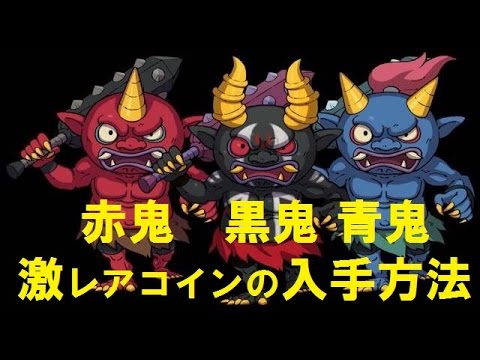
. kuro-oni, kurooni 黒鬼伝説 black Oni demon Legends .
..............................................................................................................................................
新潟県 Niigata 笹神村 Sasakamimura
Once upon a time
the girls were playing tag. One of the girls felt a strange pain in her shin and when she looked, the flesh had split and she was almost bleeding. She tried to be brave and walked all the way to the bridge. At the bridge blood was suddenly flowinig out of her leg.
It must have been a kamaitachi かまいたち "sickle weasel".
. kamaitachi 鎌鼬 cut of the skin by a cold sucking wind .
- kigo for winter
and also a strange Yokai monster.
:::::::::::::::::::::::::::::::::::::::::::::::::::::::::::::::::::::::::::::::::::::::::::::::::::::::::::::::::::::::::::::::::::::::::::::::::::::::::::::::::::::::::::::::::::
- reference : nichibun yokai database 妖怪データベース -
- reference - 鬼ごっこ -
:::::::::::::::::::::::::::::::::::::::::::::::::::::::::::::::::::::::::::::::::::::::::::::::::::::::::::::::::::::::::::::::::::::::::::::::::::::::::::::::::::::::::::::::::::
. - - - Join the Onipedia friends on facebook ! - - - .
:::::::::::::::::::::::::::::::::::::::::::::::::::::::::::::::::::::::::::::::::::::::::::::::::::::::::::::::::::::::::::::::::::::::::::::::::::::::::::::::::::::::::::::::::::
. Onipedia - 鬼ペディア - Oni Demons - ABC-List - .
. Tengu 天狗と伝説 Tengu legends "Long-nosed Goblin" .
. - yookai, yōkai 妖怪 Yokai monsters - .
. Legends and Tales from Japan 伝説 - Introduction .
. Mingei 民芸 Regional Folk Art from Japan .
:::::::::::::::::::::::::::::::::::::::::::::::::::::::::::::::::::::::::::::::::::::::::::::::::::::::::::::::::::::::::::::::::::::::::::::::::::::::::::::::::::::::::::::::::::
[ . BACK to DARUMA MUSEUM TOP . ]
[ . BACK to WORLDKIGO . TOP . ]
- #onigokko #hideandseek #onibarai #oniyarai #tsuina -
:::::::::::::::::::::::::::::::::::::::::::::::::::::::::::::::::::::::::::::::::::::::::::::::::::::::::::::::::::::::::::::::::::::::::::::::::::::::::::::::::::::::::::::::::::














